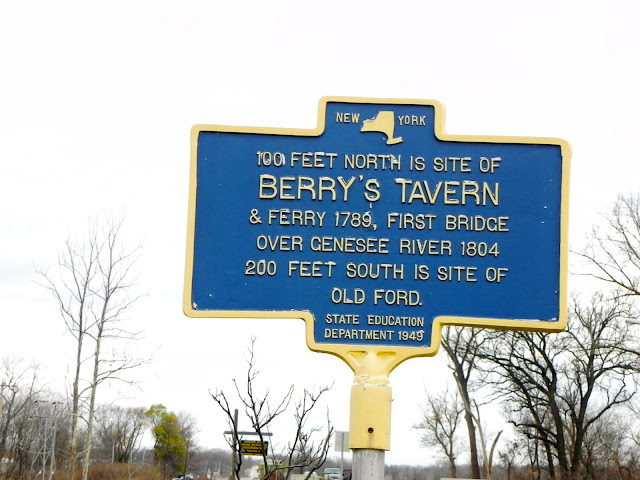By Richard F. Palmer
Avon was singularly favored in its first family and it is no exaggeration to say were"The Berrys." Yes, Gilbert R. Berry and his wife, Ann Marie, (the daughter of an Indian trader) settled here in the spring of 1789, shortly after their marriage. They settled on the east bank of the Genesee River, locating, as local history books state, "less than a rifle shot south of the old red bridge." This bridge, which replaced the ferry, was about 100 yards north of the present Route 5 and 20 bridge. The rifles of that day had a range of about that distance, so that statement is more or less accurate.
Berry had collected timbers to build a cabin, but since he was about the only white man in the region, he was at a loss as to who might be able to assist him in raising the timbers. Apparently his Indian neighbors at nearby Canawaugus (on the site of Avon) weren't willing to give him a hand. But one day a party of white men returning from a trip to Canada came by just in time and the problem was solved.
Berry who came to this country from Ireland, first settled in Albany. But he soon decided to move west. At first he stopped off at Geneva, but decided opportunities were too limited there. So he continued westward into the wilderness and staked out his land on the east bank of the Genesee River. His original log dwelling must have been enlarged considerably as it eventually served as his home as well as a tavern and a store. He also had a trading post at nearby Big Tree which was at the mouth of Canaseraga Creek, as well as at a local settlement known as Williamsburg. Today, this would be called a "chain store" system. His pack horses became a familiar sight along the wilderness trails.
Besides his enterprises, Berry also acted as the local Indian agent for General Israel Chapin, who formed the "Canandaigua Council" which led to the signing of the Canandaigua Treaty of 1794. Long before there were postal carries, Berry employed two local Indian couriers named "Sharp Shins" and "Tommy Infant" to carry messages to and from General Chapin regarding Indian affairs. It is said the Indian couriers were very dependable.
The rope ferry operated by Berry, enabled travelers to cross the river dry shod. At times the water was running too high to cross the ford. Descriptions of the ferry itself are vague, but the boat itself appears to have been of considerable size, as it could accommodate wagons. A rope was attached to trees on either ban. The ends of the boat were connected to pulleys on the rope, so that the boat could be navigated in such a way as to go with the current back and forth.
The Berry Tavern was like an oasis in the wilderness, being a favorite stopping place. European travelers frequently mentioned it in their writings. Mr. Berry died in 1797 from a malaria-like ailment known as the "Genesee Fever," but is wife continued to operate the ferry and the tavern. The Berry's had refused to sell liquor to the Indians and she continued this practice after her husband's death. The Indians called her "Te-neh-anah" because of this. The name was not meant to be derogatory, as her many kind deeds had endeared her to the Indians.
As time passed Mrs. Berry became involved in activities in the new settlement of Avon, and was active in the Congregational Church. The first bridge across the river was constructed in 1804 and the ferry was abandoned. In 1797, what became the village of Avon in 1808 was named "Hartford."
The tavern was continued until 1816 when Mrs. Berry moved to Rochester to live with her daughter and son-in-law, Catherine and John Mastic. He was a local lawyer, who became Rochester's first attorney. He had come to Avon from Rockingham, Vermont to study law with George Hosmer, who had married another daughter of the Berry's. Mastic was admitted to the bar at Canandaigua in 1808. During his stay in Avon he boarded at the Berry Tavern. Their other daughter, Effie, married George A. Tiffany, the first merchant of LeRoy. She died June 8, 1869 in Milwaukee at the age of 80. Mrs. Berry died December 10, 1829 in Avon.
The tavern was continued until 1816 when Mrs. Berry moved to Rochester to live with her daughter and son-in-law, Catherine and John Mastic. He was a local lawyer, who became Rochester's first attorney. He had come to Avon from Rockingham, Vermont to study law with George Hosmer, who had married another daughter of the Berry's. Mastic was admitted to the bar at Canandaigua in 1808. During his stay in Avon he boarded at the Berry Tavern. Their other daughter, Effie, married George A. Tiffany, the first merchant of LeRoy. She died June 8, 1869 in Milwaukee at the age of 80. Mrs. Berry died December 10, 1829 in Avon.
Sources:
P. 67, History of the Pioneer Settlement of Phelps and Gorham's Purchase. By Orasmus Turner (Rochester) 1851.
"Henry Selden Tells of Avon's First Settlement." Avon Herald-News, December 20, 1940.
Genealogical information from Roots Web



No comments:
Post a Comment